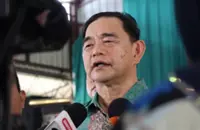How much: The question that went viral after a student’s answer was marked wrong.
DURING Geetha Nair Balakrishnan’s days as a trainee teacher, she learnt that marking questions correctly meant sticking closely to the guidelines given.
But when she joined the noble profession, she realised the importance of allowing students to answer questions in their own words and using terms they are most familiar with.
This, she added, is necessary if a teacher is to accurately evaluate the depth of their understanding on the topic and subject.
“Every student is unique, with different interests, skills, abilities, and learning styles.
“They should solve problems, design and present their project papers based on their own interpretations and creativity, as long as it does not run far from the fundamental knowledge of the topic or subject.
“That said, there must still be a balance between teaching students to follow a standardised approach and encouraging creativity or individual exploration,” Geetha, the SMK Convent Ipoh Biology panel head who has taught the subject for over two decades, told StarEdu.
Rigid marking schemes undermine Higher Order Thinking Skills (HOTS) and have led to a decline in Malaysia’s Programme for International Student Assessment (Pisa) 2022 scores, parents and teachers lament.
In January, UCSI University lecturer Assistant Prof Dr Othman Talib expressed disappointment in a Facebook post, about a teacher who failed to recognise a student’s critical thinking skills in answering a basic maths question.
The question featured in the viral post asked students to calculate how much Ahmad would have to pay if he bought a book costing 80 sen and two pencils priced at 60 sen each.
The student’s answer was RM2, which was marked incorrect because the “right answer”, presumable according to the marking scheme, was 200 sen.
The post prompted netizens to chide the teacher for being too rigid in adhering to the marking scheme.
Marking schemes, said Othman, should only serve as a guide. He said teachers should not evaluate a student’s method based solely on how he or she arrives at the answer – not unless the student is found guilty of copying a peer’s work.
Marking schemes must be flexible when there are different ways of deriving the correct answer, he said.
Typically, there may be more flexibility when marking exams for lower levels such as Year 1 as the different early developmental stages of pupils are taken into account.
However, as students progress to higher levels, expectations become more specific, he added.
In learning institutions abroad, marking schemes often conclude with a directive to “accept any possible answer”, he explained.
This approach, he said, is preferable as it enables educators to assign marks without unfairly dismissing an answer that cannot be proven wrong.
“What confuses students most are trick questions under the guise of HOTS which makes them think beyond the given context,” he added.
Be flexible
Traditional marking schemes, said Geetha, prioritise correctness over creativity and critical thinking while flexible marking gives teachers the freedom to assess student ability to think critically, solve problems creatively, and demonstrate conceptual understanding in various ways, rather than solely focusing on memorisation.
Flexible marking, she said, is important because it allows teachers to provide students with personalised and meaningful input.
“By understanding each student’s strengths and areas for improvement, teachers can offer targeted feedback that helps students progress and grow,” she said.
Agreeing, Science and Biology teacher Shaziera Ishak emphasised the importance of giving educators flexibility in marking to accurately reflect the student’s progress and preferred learning styles.
“Strict adherence to a marking scheme can be unfair to students who provide answers that are logically correct but deviate from the structure outlined in the rubric.
“Assessments should not only measure student achievement but also support individual growth and development,” she said, adding that when students feel that their individual progress and efforts are recognised and valued, they are more likely to feel motivated and engaged in their learning.
She said flexible marking communicates to students that their perspectives and contributions are important.
“It is essential for the ministry to develop marking schemes that strike a balance between providing clear guidelines for assessment and allowing flexibility for creativity, critical thinking.
“Marking schemes should be designed to assess a range of cognitive skills and competencies, including not only factual knowledge but also problem-solving, analytical thinking, communication, and collaboration,” she said.
It’s a challenge
Teachers, said Geetha, face many challenges in implementing HOTS.
“They feel pressured to teach in a one-size-fits-all manner, which indirectly forces students to focus on rote learning so that they perform well in classroom assessments.
“Questioning is key to analytical thinking, yet it often gets overshadowed by exams and rigid marking schemes,” she said.
Teachers are also constrained by the need to cover a vast amount of material within a limited time period, leaving little room for in-depth exploration or HOTS activities in the classroom, she added.
“We make an effort whenever we can to encourage HOTS in classrooms as teachers understand the significance of HOTS better than anyone,” Geetha said, adding that teachers must be equipped with the proper foundation to teach students how to answer HOTS questions.
While teachers follow the marking scheme provided to simplify the grading process, National Union of the Teaching Profession (NUTP) secretary-general Fouzi Singon said alternative answers are often considered.
“Additionally, teachers are guided by their experience in cases where a student’s answer deviates from the marking scheme.
“To mark HOTS questions effectively, teachers must be trained to evaluate a student’s answer that deviates from the marking scheme but demonstrates a conceptual understanding of the question. Such students must be given credit,” he said, adding that parents are welcome to go to school to discuss the academic progress of the student or issues they have with the assessments conducted as it is important that they understand the process.
“The teacher can then clarify and explain how the exam answers are evaluated and how the points are allocated in HOTS-oriented questions,” he said.
Critical thinkers to the fore
As a student, I have felt pressured to include certain phrases or to follow a specific template when answering subjective and essay questions in science subjects like Biology, Chemistry, and Physics. This is especially so in high-stakes exams where there are many HOTS questions and students fear losing marks if the answer does not adhere to a particular format or scheme. In such cases, I find myself memorising template answers to ensure I score maximum points. It is frustrating to rely so heavily on template answers as it can stifle creativity and analytical thinking. I hope teachers will stop being so rigid when it comes to marking our papers because answers should be accepted if they are correct regardless of whether these were outlined in the marking scheme.
– Alya Mohd Iskandar, 16 –
I’ve always believed in following template answers over prioritising creativity and analytical thinking. However, I’ve come to realise that relying solely on memorised templates can limit one’s ability to think critically and engage deeply with the question asked. I prefer to approach HOTS-oriented questions with an open mind, focusing on understanding the underlying concepts and crafting responses that showcase my analytical abilities and depth of understanding, rather than simply regurgitating memorised phrases. Unfortunately, teachers are only focused on fixed marking schemes, instead of whether a student is applying HOTS.
– Thermesh Pragas Rao, 17 –







